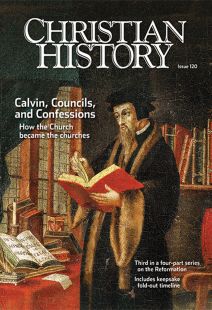Calvin, councils, and confessions: Recommended resources
BOOKS
Read about John Calvin’s life, theology, and influence in Alexandre Ganoczy, The Young Calvin (1987); François Wendel, Calvin (1995); Bernard Cottret, Calvin: A Biography (2000); Richard Muller, The Unaccommodated Calvin (2001), Christ and the Decree (2008), and Calvin and the Reformed Tradition (2012); Christopher Elwood, Calvin for Armchair Theologians (2002); David Hall and Peter Lillback, eds., A Theological Guide to Calvin’s Institutes (2008); Michiel A. van den Berg, Friends of Calvin (2009); Herman Selderhuis, John Calvin: A Pilgrim’s Life (2009); F. Bruce Gordon, Calvin (2011); David C. Steinmetz, Calvin in Context (2012); Jon Balserak, John Calvin as Sixteenth-Century Prophet (2014); Michael Horton, Calvin on the Christian Life (2014); and Bruce Gordon, John Calvin’s Institutes of the Christian Religion (2016).
Order Christian History #120: Calvin, Councils, and Confessions in print.
Subscribe now to get future print issues in your mailbox (donation requested but not required).
Life in Geneva is considered in E. William Monter, Calvin’s Geneva (1967); Karin Maag, Seminary or University? The Genevan Academy and Reformed Higher Education 1560–1620 (1995); Ronald Wallace, Calvin, Geneva, and the Reformation (1998); John Witte Jr., Sex, Marriage, and Family Life in John Calvin’s Geneva (2005); and Jennifer Powell McNutt, Calvin Meets Voltaire (2014).
Learn more about the general spread of the Reformed faith in Mark Greengrass, The French Reformation (1991); Karin Maag, ed., The Reformation in Eastern and Central Europe (1997); William Monter, Judging the French Reformation (1999); Christopher Elwood, The Body Broken (1989); Mack Holt, ed., Renaissance and Reformation France (2003); and Alastair Duke, The Reformation and Revolt in the Low Countries (2003).
The story of the English Reformation continues in Patrick Collinson, The Elizabethan Puritan Movement (1967) and The Religion of Protestants: The Church in English Society 1559–1625 (1982); A. G. Dickens, The English Reformation (1991); J. J. Scarisbrick, The Reformation and the English People (1991); Eamon Duffy, The Stripping of the Altars (1992); Diarmaid MacCulloch, The Later Reformation in England 1547–1603 (2000); Francis Bremer, Puritanism: A Very Short Introduction (2009); and Jacqueline Rose, Godly Kingship in Restoration England (2011).
Lutherans are found in Eric Gritsch and Robert Jenson, Lutheranism (1976); David Whitford, Tyranny and Resistance (2001); C. Scott Dixon, The Reformation in Germany (2002); Eric Gritsch, A History of Lutheranism (2002); John Witte Jr., Law and Protestantism (2002); and Charles Arand, Robert Kolb, and James A. Nestingen, The Lutheran Confessions (2012).
Mennonites appear in Piet Visser and Mary Sprunger, Menno Simons (1996); C. Arnold Snyder, Anabaptist History and Theology (1997); Walter Klaassen and William Klassen, Marpeck: A Life of Dissent and Conformity (2008); Peter Klassen, Mennonites in Early Modern Poland and Prussia (2009); and Abraham Friesen, Menno Simons (2015).
Finally, Roland Bainton’s series on women in the Reformation concludes with Women of the Reformation in France and England (1973) and Women of the Reformation from Spain to Scandinavia (1977).
CHRISTIAN HISTORY ISSUES
Read these past issues of Christian History online; some are still available for purchase:
• 28: 100 Most Important Events in Church History
• 71: Huguenots and the Wars of Religion
• 89: Richard Baxter and the English Puritans
• 116: 25 Writings that Changed the Church and the World
VIDEOS FROM VISION VIDEO
Videos on people and movements featured in this issue include Knox, Reformation Overview, Zwingli and Calvin, and the new original documentary This Changed Everything: 500 Years of the Reformation.
Reformation videos your kids might enjoy are Torchlighters: The Martin Luther Story and The William Tyndale Story.
WEBSITES
Many of the Christian writings mentioned in this issue can be found at the Christian Classics Ethereal Library, at Project Gutenberg, and at the Modern History Sourcebook at Fordham University in the sections called “Early Modern World” and “Reformation Europe.” Despite its title, the Post-Reformation Digital Library has many texts from this period available.
Read more about Calvin and the Reformed tradition at the H. Henry Meeter Center for Calvin Studies, the Calvin Studies Society, and The History Guide.
Anglican history is covered at The Anglican Domain and Project Canterbury, and Anabaptists at the Global Anabaptist Mennonite Encyclopedia Online, Global Anabaptist Wiki, and Anabaptists.org. Lutherans show up at The Book of Concord and Project Wittenberg. CH
This article is from Christian History magazine #120 Calvin, Councils, and Confessions. Read it in context here!
Christian History’s 2015–2017 four-part Reformation series is available as a four-pack. This set includes issue #115 Luther Leads the Way; issue #118 The People’s Reformation; issue #120 Calvin, Councils, and Confessions; and issue#122 The Catholic Reformation. Get your set today. These also make good gifts.
By The Editors
[Christian History originally published this article in Christian History Issue #120 in 2016]
Next articles
Christian History & Biography Celebrates 25 Years
We need history to inform our lives
Jennifer TraftonBenedict, Did You Know
Interesting and little-known facts about Benedictine monasticism.
The EditorsThe Tale of Peter Abbot
One of Cluny's most “venerable” leaders believed firmly that the church is always in need of reform.
Garry CritesLiving like a monk in the “real world”
Count Gerald of Aurillac took the values of the monastery into the realm of everyday life—and the battlefield.
Dennis MartinSupport us
Christian History Institute (CHI) is a non-profit Pennsylvania corporation founded in 1982. Your donations support the continuation of this ministry
Donate





